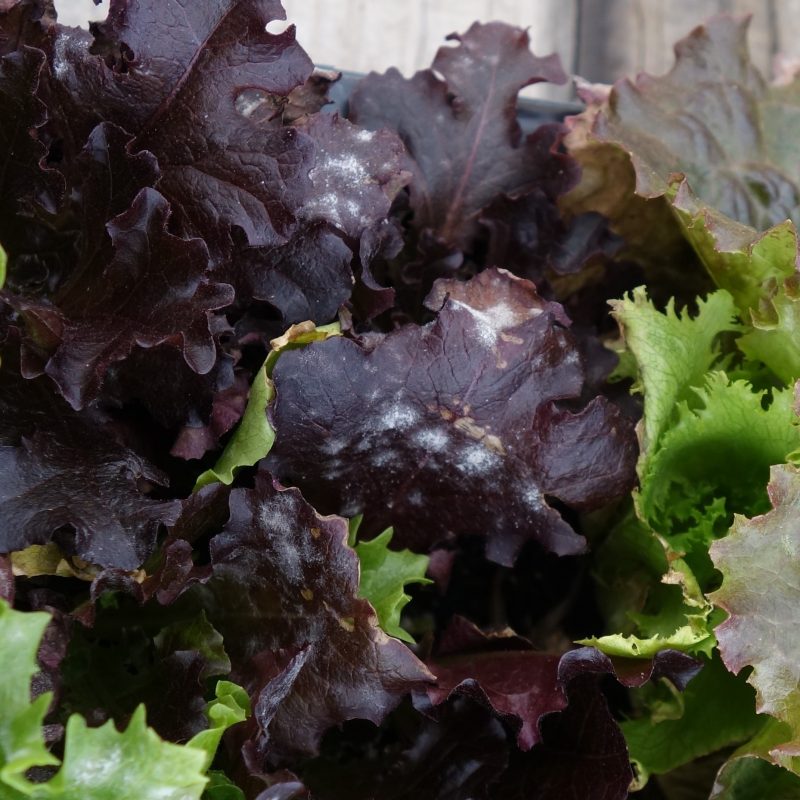Although it doesn’t happen often here because of our high, dry, climate, sometimes you will see small gray to whitish, fuzzy patches on your houseplants. Most likely this is powdery mildew. Ideal conditions for the formation of this form of mold is when the leaves are dry, the light conditions are low, temperatures are moderate, there is little air circulation, but the humidity is high which are exactly the conditions most of us have in our homes during the winter months. This is especially true if the pot remains damp for a extended period of time after watering.
The good news is that it’s one of the easier plant problems to recognize and diagnose. Although there are several types of mildew, they all look the same. When you look at your plant, you will notice splotchy white or gray fuzzy spots on the leaves. Most of the time it will be on the tops of the leaves, but powdery mildew can be on the bottoms as well, so it’s a good idea to check there from time to time.
Powdery mildew isn’t pretty, splotching up your leaves, but it isn’t fatal either and is easily treated. However, since any disease will weaken a houseplants health, you want to be sure to be on top of this once you spot it. If too much of the leaf surface becomes covered in the mold, it can impair photosynthesis and cause the leaves to drop. So now you not only have a moldy plant, but a naked one as well!
So how did your otherwise, well cared for, and clean houseplants get this? The bad news is that powdery mildew is everywhere. The fungi overwinter in plant material in your pots or out in the garden and then are spread via the spores they produce in the spring. They are carried by wind, insects or even water splashing from one plant to another.
Prevention is your biggest gun in stopping the spread of this disease. Begin with clean, healthy houseplants, or garden plants. Healthy plants are less likely to become diseased in the first place and, if they are subject to the spores and ideal conditions, they are more likely to be able to fend it off. Plants like tomatoes are constantly being bred to be more resistant to mildew because it’s known that this is such a big concern in home gardens.
Prevent the formation of powdery mildew in several ways. Avoiding overcrowding- either with your houseplants indoors, or in your garden outside. I know I have a tendency to over plant my squash patch and always seem to have mildew problems there, especially as the plants mature, the leaves get large and crowd each other, and shade the soil underneath.
Don’t over fertilize your plants. The new, tender growth is most susceptible to this disease so don’t push your plants to send out those new shoots until you have resolved the problem on the older growth. If you do, then you will just exacerbate the existing issue.
Place plants where there is adequate light and air circulation and avoid over watering. Most plants can take much less water than you think and still thrive.
If your plant already has powdery mildew, here’s what to do to clean it up. Start by removing and discarding any infected parts of the plant that you can, especially leaves that have already yellowed or those mostly covered with the mold.
Although many people are finding some success with home based organic controls such as baking soda, mouthwash, or milk, this is a problem that almost always needs a stronger control and application of a good fungicide is the best way to combat powdery mildew and clean it up before it spreads. Follow label directions for whatever you choose, but most fungicides will need to be reapplied every 7-14 days until the problem resolves itself.
An effective organic solution is copper fungicide which can not only be used on your houseplants without any damaging effects, but also on your edibles in the garden. Infuse is also a good choice. However, because this is a systemic and works up through the capillary system of the plant and remains in the plant itself, rather than just being on the surface, you don’t want to use it on anything you might eat.
Your indoor plants will thank you if you take a few minutes now to scout the leaves and make sure they are happy and healthy heading into the spring season.

